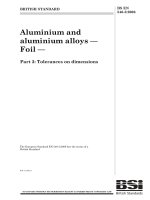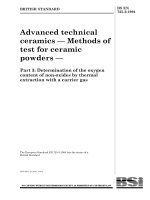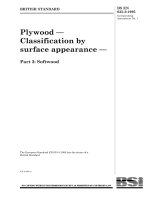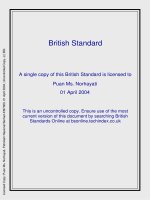Bsi bs en 61300 3 4 2013
Bạn đang xem bản rút gọn của tài liệu. Xem và tải ngay bản đầy đủ của tài liệu tại đây (1.11 MB, 22 trang )
BS EN 61300-3-4:2013
BSI Standards Publication
Fibre optic interconnecting
devices and passive
components — Basic
test and measurement
procedures
Part 3-4: Examinations and measurements —
Attenuation
BRITISH STANDARD
BS EN 61300-3-4:2013
National foreword
This British Standard is the UK implementation of EN 61300-3-4:2013. It is
identical to IEC 61300-3-4:2012. It supersedes BS EN 61300-3-4:2001 which
is withdrawn.
The UK participation in its preparation was entrusted by Technical
Committee GEL/86, Fibre optics, to Subcommittee GEL/86/2, Fibre optic
interconnecting devices and passive components.
A list of organizations represented on this committee can be obtained on
request to its secretary.
This publication does not purport to include all the necessary provisions of
a contract. Users are responsible for its correct application.
© The British Standards Institution 2013
Published by BSI Standards Limited 2013
ISBN 978 0 580 60714 1
ICS 33.180.20; 33.180.99
Compliance with a British Standard cannot confer immunity from
legal obligations.
This British Standard was published under the authority of the
Standards Policy and Strategy Committee on 31 July 2013.
Amendments issued since publication
Amd. No.
Date
Text affected
BS EN 61300-3-4:2013
EN 61300-3-4
EUROPEAN STANDARD
NORME EUROPÉENNE
EUROPÄISCHE NORM
June 2013
ICS 33.180.20
Supersedes EN 61300-3-4:2001
English version
Fibre optic interconnecting devices and passive components Basic test and measurement procedures Part 3-4: Examinations and measurements Attenuation
(IEC 61300-3-4:2012)
Dispositifs d'interconnexion et composants
passifs à fibres optiques Méthodes fondamentales d'essais et de
mesures Partie 3-4: Examens et mesures Affaiblissement
(CEI 61300-3-4:2012)
Lichtwellenleiter Verbindungselemente und passive
Bauteile Grundlegende Prüf- und Messverfahren Teil 3-4: Untersuchungen und Messungen
Dämpfung
(IEC 61300-3-4:2012)
This European Standard was approved by CENELEC on 2013-01-16. CENELEC members are bound to comply
with the CEN/CENELEC Internal Regulations which stipulate the conditions for giving this European Standard
the status of a national standard without any alteration.
Up-to-date lists and bibliographical references concerning such national standards may be obtained on
application to the CEN-CENELEC Management Centre or to any CENELEC member.
This European Standard exists in three official versions (English, French, German). A version in any other
language made by translation under the responsibility of a CENELEC member into its own language and notified
to the CEN-CENELEC Management Centre has the same status as the official versions.
CENELEC members are the national electrotechnical committees of Austria, Belgium, Bulgaria, Croatia, Cyprus,
the Czech Republic, Denmark, Estonia, Finland, Former Yugoslav Republic of Macedonia, France, Germany,
Greece, Hungary, Iceland, Ireland, Italy, Latvia, Lithuania, Luxembourg, Malta, the Netherlands, Norway, Poland,
Portugal, Romania, Slovakia, Slovenia, Spain, Sweden, Switzerland, Turkey and the United Kingdom.
CENELEC
European Committee for Electrotechnical Standardization
Comité Européen de Normalisation Electrotechnique
Europäisches Komitee für Elektrotechnische Normung
Management Centre: Avenue Marnix 17, B - 1000 Brussels
© 2013 CENELEC -
All rights of exploitation in any form and by any means reserved worldwide for CENELEC members.
Ref. No. EN 61300-3-4:2013 E
BS EN 61300-3-4:2013
EN 61300-3-4:2013
-2-
Foreword
The text of document 86B/3494/FDIS, future edition 3 of IEC 61300-3-4, prepared by IEC/SC 86B "Fibre
optic interconnecting devices and passive components", of IEC TC 86, "Fibre optics" was submitted to the
IEC-CENELEC parallel vote and approved by CENELEC as EN 61300-3-4:2013.
The following dates are fixed:
•
•
latest date by which the document has
to be implemented at national level by
national
publication of an identical
standard or by endorsement
latest date by which the national
standards conflicting
with
the
document have to be withdrawn
(dop)
2013-12-28
(dow)
2014-01-16
This document supersedes EN 61300-3-4:2001.
EN 61300-3-4:2013 includes the following significant technical changes with
EN 61300-3-4:2001:
a) revision of source conditions, launch conditions and power meter parameters;
b) addition of safety recommendations;
c) removal of launch condition details for multimode fibres, now referenced in EN 61300-1.
respect
to
Attention is drawn to the possibility that some of the elements of this document may be the subject of
patent rights. CENELEC [and/or CEN] shall not be held responsible for identifying any or all such patent
rights.
Endorsement notice
The text of the International Standard IEC 61300-3-4:2012 was approved by CENELEC as a European
Standard without any modification.
In the official version, for Bibliography, the following notes have to be added for the standards indicated:
IEC 61300-3-29
NOTE Harmonized as EN 61300-3-29.
IEC 61280-1-3
NOTE Harmonized as EN 61280-1-3.
BS EN 61300-3-4:2013
EN 61300-3-4:2013
-3-
Annex ZA
(normative)
Normative references to international publications
with their corresponding European publications
The following documents, in whole or in part, are normatively referenced in this document and are
indispensable for its application. For dated references, only the edition cited applies. For undated
references, the latest edition of the referenced document (including any amendments) applies.
NOTE When an international publication has been modified by common modifications, indicated by (mod), the relevant EN/HD
applies.
Publication
Year
Title
EN/HD
Year
IEC 60793-2
-
Optical fibres Part 2: Product specifications - General
EN 60793-2
-
IEC 60825-1
-
Safety of laser products Part 1: Equipment classification and
requirements
EN 60825-1
-
IEC 61300-1
-
Fibre optic interconnecting devices and
passive components - Basic test and
measurement procedures Part 1: General and guidance
EN 61300-1
-
IEC 61300-3-1
-
Fibre optic interconnecting devices and
passive components - Basic test and
measurement procedures Part 3-1: Examinations and measurements Visual examination
EN 61300-3-1
-
IEC 61300-3-2
-
Fibre optic interconnecting devices and
EN 61300-3-2
passive components - Basic test and
measurement procedures Part 3-2: Examinations and measurements Polarization dependent loss in a single-mode
fibre optic device
-
IEC/TR 62316
-
Guidance for the interpretation of OTDR
backscattering traces
-
-
–2–
BS EN 61300-3-4:2013
61300-3-4 © IEC:2012
CONTENTS
1
Scope ............................................................................................................................... 5
2
Normative references ....................................................................................................... 5
3
General description .......................................................................................................... 5
4
3.1 General ................................................................................................................... 5
3.2 Precautions ............................................................................................................. 6
Apparatus ......................................................................................................................... 6
5
4.1 Launch conditions and source (S) ........................................................................... 6
4.2 Optical power meter (D) .......................................................................................... 7
4.3 Temporary joint (TJ) ................................................................................................ 7
4.4 Fibre ....................................................................................................................... 7
4.5 Reference plugs (RP) .............................................................................................. 8
4.6 Reference adaptors (RA) ......................................................................................... 8
Procedure......................................................................................................................... 8
5.1
5.2
5.3
5.4
6
Pre-conditioning ...................................................................................................... 8
Visual inspection ..................................................................................................... 8
DUT configurations and test methods ...................................................................... 8
Attenuation measurements with a power meter ........................................................ 9
5.4.1 General ....................................................................................................... 9
5.4.2 Cutback method .......................................................................................... 9
5.4.3 Substitution method ................................................................................... 10
5.4.4 Insertion method (A) .................................................................................. 11
5.4.5 Insertion method (B) with direct coupling to power meter ........................... 11
5.4.6 Insertion method (C) with additional test patchcord .................................... 12
5.5 Attenuation measurements with an OTDR ............................................................. 13
5.5.1 Measurement description ........................................................................... 13
5.5.2 Bidirectional measurement ........................................................................ 14
5.5.3 Measurement method ................................................................................ 15
5.5.4 Evaluation procedure ................................................................................. 15
Details to be specified .................................................................................................... 16
Bibliography .......................................................................................................................... 17
Figure 1 – Cutback method – Type 1, Type 2 and Type 3 DUTs ............................................ 10
Figure 2 – Substitution method – Type 4 DUT ....................................................................... 10
Figure 3 – Insertion method (C1) – Type 2 DUT .................................................................... 11
Figure 4 – Insertion method (C2) – Type 5 and Type 6 DUT .................................................. 12
Figure 5 – Insertion method (C3) – Type 4, Type 5, Type 7 and Type 8 DUT ........................ 13
Figure 6 – Method 1 – One launch section ............................................................................ 14
Figure 7 – Method 2 – Two launch sections .......................................................................... 14
Figure 8 – Non-reflective event ............................................................................................. 15
Figure 9 – Reflective event ................................................................................................... 16
Table 1 – Preferred source conditions ..................................................................................... 6
Table 2 – Preferred power meter parameters .......................................................................... 7
Table 3 – DUT configurations .................................................................................................. 8
BS EN 61300-3-4:2013
61300-3-4 © IEC:2012
–5–
FIBRE OPTIC INTERCONNECTING DEVICES
AND PASSIVE COMPONENTS –
BASIC TEST AND MEASUREMENT PROCEDURES –
Part 3-4: Examinations and measurements – Attenuation
1
Scope
This part of IEC 61300 describes the various methods available to measure the attenuation of
optical components. It is not, however, applicable to dense wavelength division multiplexing
(DWDM) components, for which IEC 61300-3-29 should be used.
2
Normative references
The following documents, in whole or in part, are normatively referenced in this document and
are indispensable for its application. For dated references, only the edition cited applies. For
undated references, the latest edition of the referenced document (including any
amendments) applies.
IEC 60793-2, Optical fibres – Part 2: Product specifications – General
IEC 60825-1, Safety of laser products – Part 1: Equipment classification and requirements
IEC 61300-1:2011, Fibre optic interconnecting devices and passive components – Basic test
and measurement procedures – Part 1: General and guidance
IEC 61300-3-1, Fibre optic interconnecting devices and passive components – Basic test and
measurement procedures – Part 3-1: Examinations and measurements – Visual examination
IEC 61300-3-2, Fibre optic interconnecting devices and passive components – Basic test and
measurement procedures – Part 3-2: Examinations and measurements – Polarization
dependent loss in a single-mode fibre optic device
IEC/TR 62316, Guidance for the interpretation of OTDR backscattering traces
3
3.1
General description
General
Attenuation is intended to give a value for the decrease of useful power, expressed in
decibels, resulting from the insertion of a device under test (DUT), within a length of optical
fibre cable. The term insertion loss is sometimes used in place of attenuation.
The DUT may have more than two optical ports. However, since an attenuation measurement
is made across only two ports, the DUTs in this standard shall be described as having two
ports. Eight different DUT configurations are described. The differences between these
configurations are primarily in the terminations of the optical ports. Terminations may consist
of bare fibre, a connector plug, or a receptacle.
The reference method for measuring attenuation is with an optical power meter. Optical time
domain reflectometry (OTDR) measurements are presented as an alternative method. Three
variations in the measurement of attenuation with a power meter are presented. The reference
BS EN 61300-3-4:2013
61300-3-4 © IEC:2012
–6–
and alternative methods to be used for each DUT configuration are defined in Table 3.
Different test configurations and methods will result in different accuracies of the attenuation
being measured. In cases of dispute, the reference test method should be used.
3.2
Precautions
The power in the fibre shall not be at a level high enough to generate non-linear scattering
effects.
The position of the fibres in the test should be fixed between the measurement of P 0 and P 1 to
avoid changes in attenuation due to bending loss.
In multimode measurements, a change in modal distribution in the measurement system due
to fibre disturbance, will affect the attenuation measurement.
Components with polarization dependent loss will show different attenuation depending on the
input state of polarization from the source. If the component PDL can exceed the acceptable
uncertainty in the attenuation measurement, then either an unpolarized or polarization
scrambled source can be used to measure the polarization averaged attenuation or the
methods of IEC 61300-3-2 should be used to measure PDL and attenuation together.
The safety recommendations in IEC 60825-1, Safety of laser products, should be followed.
4
Apparatus
4.1
Launch conditions and source (S)
Table 1 – Preferred source conditions
No.
Type
Central wavelength
nm
Spectral width
nm
Source type
S1
Multi-mode
660 ± 30
≥30
Monochromator or LED
S2
Multi-mode
780 ± 30
≥30
Monochromator or LED
S3
Multi-mode
850 ± 30
≥30
Monochromator or LED
S4
Multi-mode
1 300 ± 30
≥30
Monochromator or LED
S5
Single-mode
1 310 ± 30
To be reported
Laser diode monochromator or LED
S6
Single-mode
1 550 ± 30
To be reported
Laser diode monochromator or LED
S7
Single-mode
1 625 ± 30
To be reported
Laser diode monochromator or LED
NOTE 1 It is recognized that some components, e.g. for CWDM, may require the use of other source types such
as tunable lasers. It is therefore recommended in these cases that the preferred source characteristics are
specified on the basis of the component to be measured.
NOTE 2
Central wavelength and spectral width are defined in IEC 61280-1-3.
The launch condition shall be specified in accordance with Clause 9 of IEC 61300-1:2011.
The source unit consists of an optical emitter, the associated drive electronics and fibre pigtail
(if any). Preferred source conditions are given in Table 1. The stability of the single-mode
fibre source at 23 °C shall be ±0,01 dB over the duration of the measurement. The stability of
the multimode fibre source at 23 °C shall be ± 0,05 dB over the duration of the measurement.
The source output power shall be ≥ 20 dB above the minimum measurable power level.
BS EN 61300-3-4:2013
61300-3-4 © IEC:2012
4.2
–7–
Optical power meter (D)
The power meter unit consists of an optical detector, the mechanism for connecting to it and
associated detection electronics. The connection to the detector will either be with an adaptor
that accepts a bare fibre or a connector plug of the appropriate design.
The measurement system shall be stable within specified limits over the period of time
required to measure P 0 and P 1 . For measurements where the connection to the detector must
be broken between the measurement of P 0 and P 1 , the measurement repeatability shall be
within 0,02 dB. A detector with a large sensitive area may be used to achieve this.
The precise characteristics of the detector shall be compatible with the measurement
requirements. The dynamic range of the power meter shall be capable of measuring the
power level exiting from the DUT at the wavelength being measured.
The preferred power meter parameters are given below in Table 2. The power meter shall be
calibrated for the operational wavelength and power level. The power meter stability should
be ≤ 0,01 dB over the measurement time and operational temperature range. The stability and
validity of dark current corrections from zeroing calibration can influence this.
Table 2 – Preferred power meter parameters
Number
Type
Maximum nonlinearity
dB
Relative uncertainty
dB
D1
Multi-mode
± 0,05
(-60 dBm < input power < –5 dBm)
≤ 0,05
D2
Single-mode
± 0,01
(attenuation < 10 dB)
± 0,05
(10 dB < attenuation < 60 dB)
≤ 0,02
NOTE 1 In order to ensure that all light exiting the fibre is detected by the power meter, the sensitive area of the
detector and the relative position between it and the fibre should be compatible with the numerical aperture of the
fibre.
NOTE 2 Common sources of relative uncertainty are polarization dependence and interference with reflections
from the power meter and fibre connector surfaces. The sensitivity of the power meter to such reflections can be
characterized by the parameter spectra ripple, determined as the periodic change in responsivity vs. the
wavelength of a coherent light source.
4.3
Temporary joint (TJ)
This is a method, device or mechanical fixture for temporarily aligning two fibre ends into a
stable, reproducible, low-loss joint. It is used when direct connection of the DUT to the
measurement system is not achievable by a standard connector. It may, for example, be a
precision V-groove, vacuum chuck, a micromanipulator or a fusion or mechanical splice. The
temporary joint shall be stable to within ±10 % of the required measurement accuracy in dB
over the time taken to measure P 0 and P 1 . A suitable refractive index matching material may
be used to improve the stability of the TJ.
4.4
Fibre
The fibre in the lead from the source to the temporary joint, in the test patchcord, and in the
substitute patchcord, shall belong to the same category as that used in the DUT.
Fibres should be in accordance with IEC 60793-2.
–8–
4.5
BS EN 61300-3-4:2013
61300-3-4 © IEC:2012
Reference plugs (RP)
Where reference plugs are required to form complete connector assemblies in any of the test
methods, the reference plugs become in effect a part of the DUT during the measurement of
attenuation. Reference plugs shall be specified in the relevant specification.
4.6
Reference adaptors (RA)
Where reference adaptors are required to form complete connector assemblies in any of the
test methods, the reference adaptors become in effect a part of the DUT during the
measurement of attenuation. Reference adaptors shall be specified in the relevant
specification.
5
Procedure
5.1
Pre-conditioning
The optical interfaces of the DUT shall be clean and free from any debris likely to affect the
performance of the test and any resultant measurements. The manufacturer’s cleaning
procedure shall be followed.
The DUT shall be allowed to stabilize at room temperature for at least 1 h prior to testing.
Care should be exercised throughout the test to ensure that mating surfaces are not
contaminated with oil or grease. It is recognized that bare fingers can deposit a film of grease.
5.2
Visual inspection
The optical interfaces shall be free from defects or damage which may affect the performance
of the test and any resultant measurements. It is recommended that a visual inspection of the
optical interfaces of the DUT is made in accordance with IEC 61300-3-1 prior to the start of
the test.
5.3
DUT configurations and test methods
Table 3 – DUT configurations
Test methods
Type
Description
DUT
Reference test
method
RTM
Alternative
test method
ATM
1
Fibre to fibre
(component)
Power meter
(cutback)
OTDR
2
Fibre to fibre
(splice or field-mountable
connector set)
Power meter
(insertion A)
Power meter
(cutback)
Fibre to plug
Power meter
3
Or OTDR
OTDR
(cutback)
4
Plug to plug
(component)
C
Power meter
(insertion B)
Power meter
(insertion C)
Or OTDR
5
Plug to plug
(patchcord)
Power meter
(insertion B)
Power meter
(insertion C)
Or OTDR
BS EN 61300-3-4:2013
61300-3-4 © IEC:2012
–9–
Test methods
Type
Description
DUT
Reference test
method
RTM
Alternative
test method
ATM
6
Single plug
(pigtail)
Power meter
(insertion B)
OTDR
7
Receptacle to
receptacle
Power meter
(insertion C)
Power meter
(substitution)
(component)
8
Or OTDR
Receptacle to plug
Power meter
(insertion C)
(component)
Power meter
(substitution)
Or OTDR
C is a passive optical component which may have more than the two ports indicated. Insertion
measurements and cutback measurements may be expected to give equivalent
measurements for type 2 DUTs.
Due to measurement considerations, the OTDR method may be less accurate than other
measurement methods but may be the only test applicable.
An OTDR can be used on components with more than two ports, but in this case the reflected
power from the ports not being measured should be suppressed in the attenuation zone.
5.4
5.4.1
Attenuation measurements with a power meter
General
The measurement of attenuation using cutback, substitution or insertion is based on the use
of an optical power meter,as described in 4.2.
Two measurements of power are required for each measurement of attenuation, A, with a
power meter:
P
A = −10 log 1 dB
P0
(1)
where
P 1 is the measurement of power with the DUT in the path;
P 0 is the measurement of power without the DUT in the path.
Suitable connections shall be provided between the fibre and the detector. Connections may
be with either an adaptor to connect a bare fibre or with a connector adaptor for the
appropriate connector.
5.4.2
Cutback method
For a type 1 and type 2 DUT, one lead of the DUT is connected to the source with a TJ. The
other lead is connected to the detector, and P 1 is measured (see Figure 1). The fibre is cut at
CP, and P 0 is measured.
BS EN 61300-3-4:2013
61300-3-4 © IEC:2012
– 10 –
CP
S
DUT
D
TJ
PM
P1
IEC
D
PM
2176/12
CP
S
TJ
P0
Figure 1 – Cutback method – Type 1, Type 2 and Type 3 DUTs
For a Type 3, fibre-to-plug DUT, a reference adaptor and a reference plug with a pigtail are
added to the DUT to form a complete connector assembly. Attenuation of a Type 3 DUT is the
attenuation of the complete connector assembly with pigtail leads, and is measured as a
Type 1 DUT.
5.4.3
Substitution method
In the substitution method, P 1 is measured with the DUT in the circuit, and P 0 is measured
with a substitute patchcord in place of the DUT (see Figure 2).
For a type 4 DUT, reference adaptors are added to the reference plugs on both the source
lead and the test patchcord (see Figure 2).
Substitute
patchcord
RA
Test
patchcord
RA
S
TJ
RP
RP
RP
RP
D
P0
DUT
RA
S
TJ
RP
PM
IEC
2178/12
Test
patchcord
RA
C
RP
D
P1
Figure 2 – Substitution method – Type 4 DUT
PM
IEC
2179/12
BS EN 61300-3-4:2013
61300-3-4 © IEC:2012
– 11 –
For a Type 7 DUT, the measurement is made in the same way as a plug-to-plug DUT, except
that reference adaptors are not required for the measurement of P 1 (see Figure 2).
For a Type 8 DUT the measurement is made in the same way as for a plug-to-plug DUT,
except that only one reference adaptor is required for the measurement of P 1 (see Figure 2).
In this case, the reference adaptor shall be the one nearest the source.
Substitution measurements may be expected to give somewhat lower results of attenuation
than insertion measurements for types 4, 5, 6, and 7 DUTs. This is due to the fact that in the
substitution method the reference power P 0 includes the attenuation of the ‘substitute
patchcord’ with its connections to the measurement system. Therefore, the value of P 0 in the
substitution method is lower than in the insertion method.
5.4.4
Insertion method (A)
For a type 2 fibre-to-fibre DUT (splice- or field-mountable connector set), P 0 is measured with
a length of fibre between the temporary joint and the detector, the fibre is cut, the splice- or
field-mountable connector set is installed, and P 1 is measured (see Figure 3).
S
D
PM
TJ
P0
S
D
TJ
Splice
P1
IEC
2180/12
PM
IEC
2181/12
Figure 3 – Insertion method (C1) – Type 2 DUT
5.4.5
Insertion method (B) with direct coupling to power meter
For a Type 5 and Type 6 DUT, P 0 is measured with the detector connected to a reference
plug on the fibre from the temporary joint. A reference adaptor and the DUT are added, and
P 1 is measured (see Figure 4).
BS EN 61300-3-4:2013
61300-3-4 © IEC:2012
– 12 –
S
D
TJ
PM
RP
P0
IEC
2182/12
DUT
RA
S
D
TJ
RP
P1
PM
IEC
2183/12
Figure 4 – Insertion method (C2) – Type 5 and Type 6 DUT
This measurement includes only the plug on the source end of the DUT in the measurement.
To measure both ends of the DUT the measurement shall be repeated with the patchcord
reversed.
For a Type 6 DUT the measurement requires an adaptor for a bare fibre at the detector.
5.4.6
Insertion method (C) with additional test patchcord
For a Type 4 plug-to-plug (component) DUT or a type 5 plug-to-plug (patchcord) DUT, P 0 is
measured with the test patchcord connected between the detector and the lead from the
temporary joint. The DUT and another reference adaptor are added, to measure P 1 (see
Figure 5).
BS EN 61300-3-4:2013
61300-3-4 © IEC:2012
– 13 –
Test patchcord
RA
S
TJ
RP
RP
RA
TJ
RP
PM
P0
IEC
2184/12
Test
patchcord
DUT
S
D
RA
C
RP
D
P1
PM
IEC
2185/12
Figure 5 – Insertion method (C3) – Type 4, Type 5, Type 7 and Type 8 DUT
For a Type 7 receptacle-to-receptacle DUT, reference adaptors are not required for the
measurement of P 1 .
For a Type 8 receptacle-to-plug DUT, only one reference adaptor is required for the
measurement of P 1 .
5.5
5.5.1
Attenuation measurements with an OTDR
Measurement description
An OTDR measures the level of radiation scattered back by the optical line and collected by
the receiver of the instrument. Using an OTDR, it is possible to measure and to evaluate both
point events due, for example, to passive components such as splices, connectors,
attenuators, etc. or losses due to the attenuation of fibre sections terminated by passive
components.
There are two principal measurement methods used depending on the DUT configuration (see
Table 3):
Method 1 – One launch section (see Figure 6) is applicable to DUT Types 1, 2, 3;
Method 2 – Two launch sections (see Figure 7) is applicable to DUT Types 4, 5, 6, 7, 8.
– 14 –
LS1
OTDR
61300-3-4 © IEC:2012
b
a
DUT
LX
L1
IEC 2186/12
Figure 6 – Method 1 – One launch section
OTDR
LS1
L1
a
b
DUT
LX
LS2
L2
IEC 2187/12
Figure 7 – Method 2 – Two launch sections
Fibre launch sections LS1 and LS2 provide separation between the OTDR equipment and the
events to be measured and ensure stable measurement conditions. Their minimum length is
determined by the ability of the OTDR to resolve the measurement of attenuation and is
commonly referred to as the attenuation dead zone (DZ att ). The maximum length of the launch
section is limited by requirement to minimize the OTDR distance resolution and to minimize
optical losses of measured route.
If the DUT section length L X is greater than the OTDR resolution (L X > DZ att ), then the
attenuation for each event, a and b, will be displayed separately. Where L X < DZ att , the OTDR
will be unable to distinguish between events a and b and the DUT will be shown as one
attenuation event.
Where the DUT is terminated with either a connector plug or a receptacle, reference plugs
and adaptors are added, as necessary, to form complete connector assemblies. These
connector assemblies are considered part of the DUT.
Where the component has pigtails, connector points are required. The pigtail lengths shall be
greater than the OTDR resolution for each event to be displayed separately.
5.5.2
Bidirectional measurement
The value of attenuation is determined from the intensity difference of back-scattering before
and after the DUT, so the launch section LS2 is needed if the DUT does not itself have
sufficiently long pigtails, compared to the dead zone. Since the backscattering coefficient of
the fibre before and after the DUT can differ, the OTDR measurement shall be made from
both ends of the assembly of DUT and launch sections, without changing the ordering of this
assembly. The attenuation result is the average of the apparent attenuation from the two
OTDR measurements.
Differences in the backscatter coefficient of the fibre on either side of the DUT will result in an
error in a one-way OTDR measurement. The error in a measurement made in one direction
will be positive and the error in the other direction will be negative. The use of an average of
readings taken in opposite directions cancels the error due to differences in the backscatter
coefficient of the two fibres.
BS EN 61300-3-4:2013
61300-3-4 © IEC:2012
– 15 –
Referring to the two measured attenuation values, illustrated in 5.5.4, as A 1 and A 2 , the
average attenuation is calculated as:
A=
A1 + A2
(dB).
2
(2)
See IEC/TR 62316 for further details.
5.5.3
Measurement method
–
Configure the apparatus as shown in Figure 6 or Figure 7 with the OTDR equipment
connected to side a.
–
Set the OTDR measurement characteristics.
–
Take an attenuation measurement in direction a-b and save the resulting OTDR data for
evaluation.
–
Configure the apparatus as shown in Figure 6 or Figure 7 with the OTDR equipment
connected to side b.
–
Set the same OTDR measurement characteristics as for the side a.
–
Take an attenuation measurement in direction b-a and save the resulting OTDR data for
evaluation.
5.5.4
5.5.4.1
Evaluation procedure
General
A typical OTDR display of the backscatter signal from a DUT with a non-reflective event is
illustrated in Figure 8a and Figure 8b.
(1)
(1)
(5)
(2) ≡ (2a)
(2)
A
A
(3)
(4)
(4)
IEC 2188/12
Figure 8a – Five-point evaluation
(3) ≡(3a)
IEC 2189/12
Figure 8b – Four-point evaluation
Figure 8 – Non-reflective event
A typical OTDR display of the backscatter signal from a DUT with a reflective event is
illustrated in Figure 9a and Figure 9b. To avoid the reflection peak affecting the attenuation
measurement, the distance between the reference markers and the peak should be suitably
long. Alternatively, a suitable filter, specified in the relevant specification, should be used to
mask the reflection.
BS EN 61300-3-4:2013
61300-3-4 © IEC:2012
– 16 –
(1)
(1)
(5)
(2) ≡ (2a)
(2)
A
A
(3)
(3) ≡ (3a)
(4)
(4)
IEC 2191/12
IEC 2190/12
Figure 9a – Five-point evaluation
Figure 9b – Four-point evaluation
Figure 9 – Reflective event
5.5.4.2
Five-point evaluation
Set evaluation points (1) and (2) on the fibre section in front of the DUT and (3) and (4) on the
fibre section behind the DUT. Set the position of decision point (5). Attenuation, A, shall be
calculated as the power level difference at point (5) between the least squares approximation
curve of the fibre section in front of the DUT and the least squares approximation curve of the
fibre behind the DUT.
5.5.4.3
Four-point evaluation
Set evaluation points (1) and (2) on the fibre section in front of the DUT and (3) and (4) on the
fibre section behind the DUT. Attenuation, A, shall be calculated as the power-level difference
between point (2a) of the least squares approximation curve of the fibre section in front of the
DUT and point (3a) of least squares approximation curve of the fibre behind the DUT.
6
Details to be specified
The following details, as applicable, shall be specified in the relevant specification:
–
test method;
–
source characteristics;
–
performance requirements (allowable attenuation);
–
power meter characteristics;
–
relevant fibre parameters;
–
OTDR characteristics
–
•
wavelength,
•
refractive index value used,
•
range,
•
pulse width,
•
averaging time,
•
lengths L 1 , L 2 , L x ;
deviations from this test method.
BS EN 61300-3-4:2013
61300-3-4 © IEC:2012
– 17 –
Bibliography
IEC 61300-3-29, Fibre optic interconnecting devices and passive components – Basic test
and measurement procedures – Part 3-29 Examinations and measurements – Measurement
techniques for characterizing the amplitude of the spectral transfer function of DWDM
components
IEC 61280-1-3, Fibre optic communication subsystem test procedures – Part 3-1: General
communication subsystems – Central wavelength and spectral width measurement
_____________
This page deliberately left blank
This page deliberately left blank
NO COPYING WITHOUT BSI PERMISSION EXCEPT AS PERMITTED BY COPYRIGHT LAW
British Standards Institution (BSI)
BSI is the national body responsible for preparing British Standards and other
standards-related publications, information and services.
BSI is incorporated by Royal Charter. British Standards and other standardization
products are published by BSI Standards Limited.
About us
Revisions
We bring together business, industry, government, consumers, innovators
and others to shape their combined experience and expertise into standards
-based solutions.
Our British Standards and other publications are updated by amendment or revision.
The knowledge embodied in our standards has been carefully assembled in
a dependable format and refined through our open consultation process.
Organizations of all sizes and across all sectors choose standards to help
them achieve their goals.
Information on standards
We can provide you with the knowledge that your organization needs
to succeed. Find out more about British Standards by visiting our website at
bsigroup.com/standards or contacting our Customer Services team or
Knowledge Centre.
Buying standards
You can buy and download PDF versions of BSI publications, including British
and adopted European and international standards, through our website at
bsigroup.com/shop, where hard copies can also be purchased.
If you need international and foreign standards from other Standards Development
Organizations, hard copies can be ordered from our Customer Services team.
Subscriptions
Our range of subscription services are designed to make using standards
easier for you. For further information on our subscription products go to
bsigroup.com/subscriptions.
With British Standards Online (BSOL) you’ll have instant access to over 55,000
British and adopted European and international standards from your desktop.
It’s available 24/7 and is refreshed daily so you’ll always be up to date.
You can keep in touch with standards developments and receive substantial
discounts on the purchase price of standards, both in single copy and subscription
format, by becoming a BSI Subscribing Member.
PLUS is an updating service exclusive to BSI Subscribing Members. You will
automatically receive the latest hard copy of your standards when they’re
revised or replaced.
To find out more about becoming a BSI Subscribing Member and the benefits
of membership, please visit bsigroup.com/shop.
With a Multi-User Network Licence (MUNL) you are able to host standards
publications on your intranet. Licences can cover as few or as many users as you
wish. With updates supplied as soon as they’re available, you can be sure your
documentation is current. For further information, email
BSI Group Headquarters
389 Chiswick High Road London W4 4AL UK
We continually improve the quality of our products and services to benefit your
business. If you find an inaccuracy or ambiguity within a British Standard or other
BSI publication please inform the Knowledge Centre.
Copyright
All the data, software and documentation set out in all British Standards and
other BSI publications are the property of and copyrighted by BSI, or some person
or entity that owns copyright in the information used (such as the international
standardization bodies) and has formally licensed such information to BSI for
commercial publication and use. Except as permitted under the Copyright, Designs
and Patents Act 1988 no extract may be reproduced, stored in a retrieval system
or transmitted in any form or by any means – electronic, photocopying, recording
or otherwise – without prior written permission from BSI. Details and advice can
be obtained from the Copyright & Licensing Department.
Useful Contacts:
Customer Services
Tel: +44 845 086 9001
Email (orders):
Email (enquiries):
Subscriptions
Tel: +44 845 086 9001
Email:
Knowledge Centre
Tel: +44 20 8996 7004
Email:
Copyright & Licensing
Tel: +44 20 8996 7070
Email:









